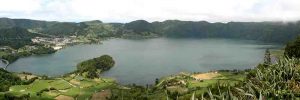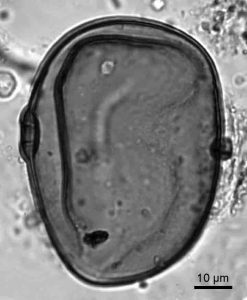
The Portuguese settled the Azores archipelago in 1449, according to the official chronology. But the analysis of the pollen present in the sediments of Lake Azul, in the São Miguel Island, suggests that the first settlers arrived to the archipelago, at least, 150 years before. This is the main conclusion of a study carried out by an international team of scientists that has been recently published in the journal Quaternary Science Reviews.
The researchers extracted a sedimentary core from Lake Azul, in the São Miguel Island, from which they took about 60 samples for pollen analysis. “In the samples studied, we found pollen of rye and other cereals and also spores from fungi characteristic of the feces of domestic animals,” says Valentí Rull, researcher at the Institute of Earth Sciences Jaume Almera (ICTJA-CSIC), and Arantzazu Lara, from the Botanic Institute of Barcelona (IBB-CSIC), who carried out the pollen analyses and the vegetation reconstruction.
Carbon-14 dating allowed researchers to know the age of samples containing the first evidence of human presence, which resulted to date back to year 1300, almost a century and a half before the onset of the Portuguese colonization. Some maps from the XIV century already documented the existence of the archipelago, but it was considered still uninhabited.
“The pollen and fungal spores found in the sediments corresponding to year 1300 suggest us that there was already some small-scale farming and livestock activity around the lake by that time. It is possible that sailors made frequent stops in the island or that there were already small permanent or intermittent settlements around Lake Azul”, adds Valentí Rull.
These settlements would have been established shortly after the last volcanic eruption, which occurred in the island around 1280. It is not known yet if humans inhabited the island before the eruption, an issue that should be verified in future studies.

The impact of colonization
The paper presents a reconstruction of the landscape and the vegetation of the São Miguel island during the last 700 years using the sediments of Lake Azul. Gonzalo Velho Cabral took possession of Santa María and São Miguel islands in 1432 but it was not until 1449 that the Kingdom of Portugal officially ordered the large-scale colonization of the archipelago.
Until then, the São Miguel landscape was dominated by dense laurisilva forests, characteristic of the Azores.The deforestation and further introduction of exotic species began after the arrival of the Portuguese settlers. This resulted in the total disappearance of the original laurisilvas. Nowadays, the island’s forests are dominated by exotic trees brought from Japan, Australia and the Mediterranean.
“In the samples corresponding to the period previous to the Portuguese settlement, we found at the same time the pollen corresponding to cereals and to laurisilva species. This indicates that the first settlements established in the island would not have modified the original vegetation, as it happened after 1449 “, says Valentí Rull.
The island of São Miguel is part of the eastern group of the Azores and is the largest and most populated island of the archipelago with more than 125,000 inhabitants.
The present study was carried out by researchers from ICTJA-CSIC, IBB-CSIC, the University of Barcelona (UB), the Institute of Environmental Science and Technology of the Autonomous University of Barcelona (ICTA-UAB) and the University of La Coruña, in conjunction with researchers from the universities of the Azores and Lisbon, and two Australian universities.
Reference:
Rull, V., et al. (2017), Vegetation and landscape dynamics under natural and anthropogenic forcing on the Azores Islands: A 700-year Pollen record from the São Miguel Island, Quaternary Science Reviews, 159, 155-168, DOI:10.1016 / j.quascirev.2017.01.021.
Note: The above post is reprinted from materials provided by Institut de Ciències de la Terra Jaume Almera.










